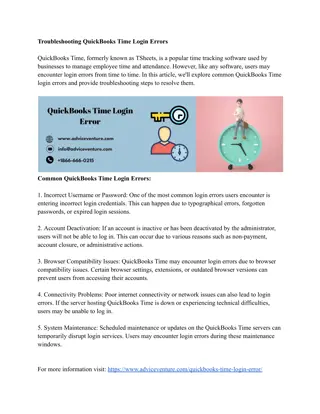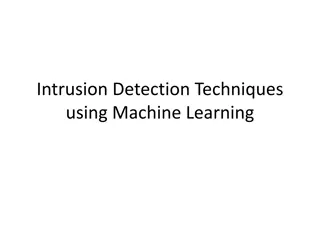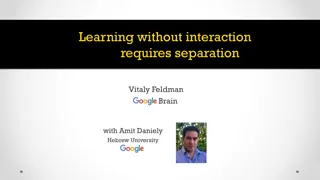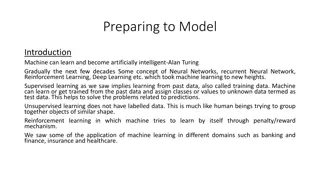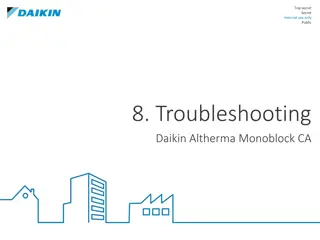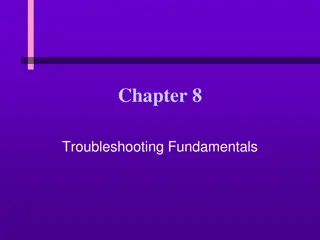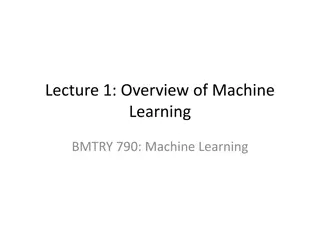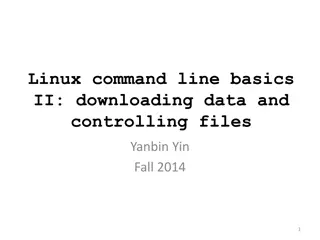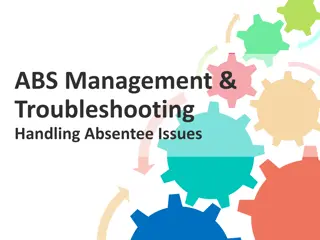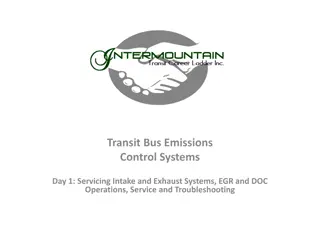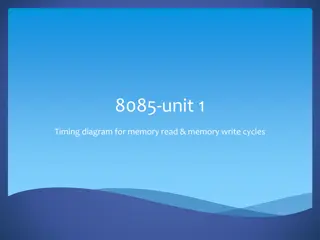Troubleshooting Machine Learning Systems: Tips and Strategies
Dive into the world of diagnosing and debugging machine learning systems with insights on fixing learning algorithms, understanding model failures, and strategies for improvement. Explore the importance of data collection, feature selection, hyperparameter tuning, and more to enhance your system's performance and achieve lower generalization errors in your models.
Download Presentation

Please find below an Image/Link to download the presentation.
The content on the website is provided AS IS for your information and personal use only. It may not be sold, licensed, or shared on other websites without obtaining consent from the author.If you encounter any issues during the download, it is possible that the publisher has removed the file from their server.
You are allowed to download the files provided on this website for personal or commercial use, subject to the condition that they are used lawfully. All files are the property of their respective owners.
The content on the website is provided AS IS for your information and personal use only. It may not be sold, licensed, or shared on other websites without obtaining consent from the author.
E N D
Presentation Transcript
Diagnosing ML System Shih-Yang Su Virginia Tech ECE-5424G / CS-5824 Spring 2019
Today's Lectures How to fix your learning algorithm Basically ZERO MATH
Debugging a learning algorithm You have built you awesome linear regression model predicting price Work perfectly on you testing data Source: Andrew Ng
Debugging a learning algorithm You have built you awesome linear regression model predicting price Work perfectly on you testing data Then it fails miserably when you test it on the new data you collected Source: Andrew Ng
Debugging a learning algorithm You have built you awesome linear regression model predicting price Work perfectly on you testing data Then it fails miserably when you test it on the new data you collected What to do now? Source: Andrew Ng
Things You Can Try Get more data Try different features Try tuning your hyperparameter
Things You Can Try Get more data Try different features Try tuning your hyperparameter But which should I try first?
Diagnosing Machine Learning System Figure out what is wrong first Diagnosing your system takes time, but it can save your time as well Ultimate goal: low generalization error
Diagnosing Machine Learning System Figure out what is wrong first Diagnosing your system takes time, but it can save your time as well Ultimate goal: low generalization error Source: reddit?
Diagnosing Machine Learning System Figure out what is wrong first Diagnosing your system takes time, but it can save your time as well Ultimate goal: low generalization error Source: reddit?
Problem: Fail to Generalize Model does not generalize to unseen data Fail to predict things that are not in training sample Pick a model that has lower generalization error
Evaluate Your Hypothesis Price ($) Price ($) Price ($) Size (ft) Size (ft) Size (ft) Source: Andrew Ng
Evaluate Your Hypothesis Price ($) Price ($) Price ($) Size (ft) Size (ft) Size (ft) Underfit Just right Overfit Source: Andrew Ng
Evaluate Your Hypothesis Price ($) Price ($) Price ($) Size (ft) Size (ft) Size (ft) Underfit Just right Overfit What if the feature dimension is too high? Source: Andrew Ng
Model Selection Model does not generalize to unseen data Fail to predict things that are not in training sample Pick a model that has lower generalization error
Model Selection Model does not generalize to unseen data Fail to predict things that are not in training sample Pick a model that has lower generalization error How to evaluate generalization error?
Model Selection Model does not generalize to unseen data Fail to predict things that are not in training sample Pick a model that has lower generalization error How to evaluate generalization error? Split your data into train, validation, and test set. Use test set error as an estimator of generalization error
Model Selection Training error Validation error Test error
Model Selection Training error Procedure: Step 1. Train on training set Step 2. Evaluate validation error Step 3. Pick the best model based on Step 2. Step 4. Evaluate the test error Validation error Test error
Bias/Variance Trade-off Price ($) Price ($) Price ($) Size (ft) Size (ft) Size (ft) Underfit Overfit Just right Source: Andrew Ng
Bias/Variance Trade-off Price ($) Price ($) Price ($) Size (ft) Size (ft) Size (ft) Underfit High bias Overfit High Variance Just right Source: Andrew Ng
Bias/Variance Trade-off Price ($) Price ($) Price ($) Size (ft) Size (ft) Size (ft) Underfit High bias Too simple Overfit High Variance Too Complex Just right Source: Andrew Ng
Linear Regression with Regularization Price ($) Price ($) Price ($) Size (ft) Size (ft) Size (ft) Underfit High bias Too simple Overfit High Variance Too Complex Too little regularization Just right Too much regularization Source: Andrew Ng
Bias / Variance Trade-off Training error Cross-validation error Loss Degree of Polynomial Source: Andrew Ng
Bias / Variance Trade-off Training error Cross-validation error High bias High Variance Loss Degree of Polynomial
Bias / Variance Trade-off with Regularization Training error Cross-validation error Loss Source: Andrew Ng
Bias / Variance Trade-off with Regularization Training error Cross-validation error High Variance High bias Loss Source: Andrew Ng
Problem: Fail to Generalize Should we get more data?
Problem: Fail to Generalize Should we get more data? Getting more data does not always help
Problem: Fail to Generalize Should we get more data? Getting more data does not always help How do we know if we should collect more data?
Learning Curve m=1 m=2 m=3 m=4 m=5 m=6
Learning Curve m=1 m=2 m=3 m=4 m=5 m=6
Learning Curve Underfit High bias Overfit High Variance
Learning Curve Does adding more data help? Price ($) Size (ft) Underfit High bias
Learning Curve Does adding more data help? Price ($) Size (ft) Underfit High bias
Learning Curve Does adding more data help? Price ($) Size (ft) Underfit High bias
Learning Curve Does adding more data help? Price ($) Price ($) Size (ft) Size (ft) More data doesn't help when your model has high bias
Learning Curve Does adding more data help? Price ($) Size (ft) Overfit High Variance
Learning Curve Does adding more data help? Price ($) Size (ft) Overfit High Variance
Learning Curve Does adding more data help? Price ($) Price ($) Size (ft) Size (ft) More data is likely to help when your model has high variance
Things You Can Try Get more data When you have high variance Try different features Adding feature helps fix high bias Using smaller sets of feature fix high variance Try tuning your hyperparameter Decrease regularization when bias is high Increase regularization when variance is high
Things You Can Try Get more data When you have high variance Try different features Adding feature helps fix high bias Using smaller sets of feature fix high variance Try tuning your hyperparameter Decrease regularization when bias is high Increase regularization when variance is high Analyze your model before you act





